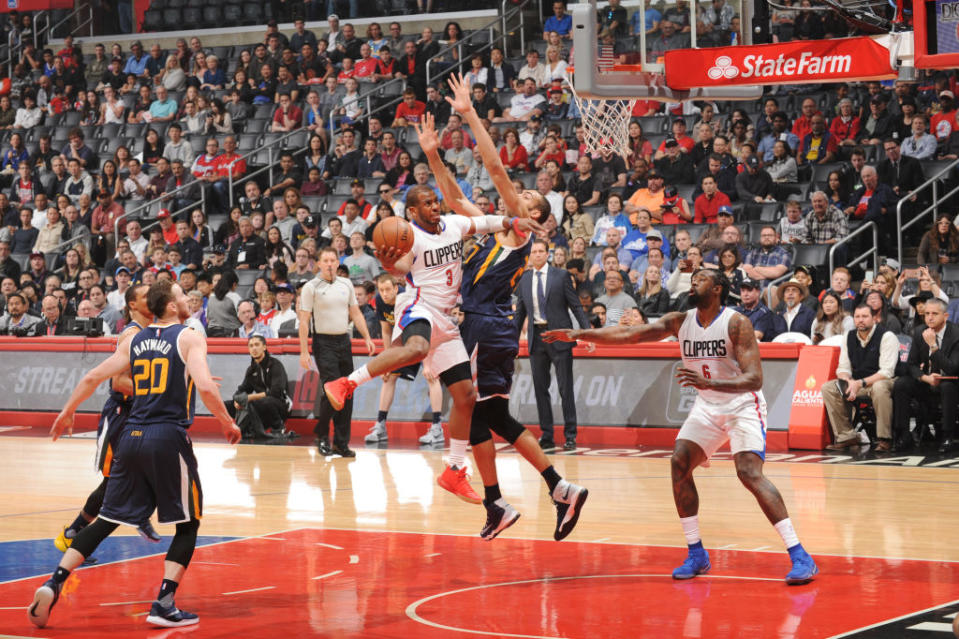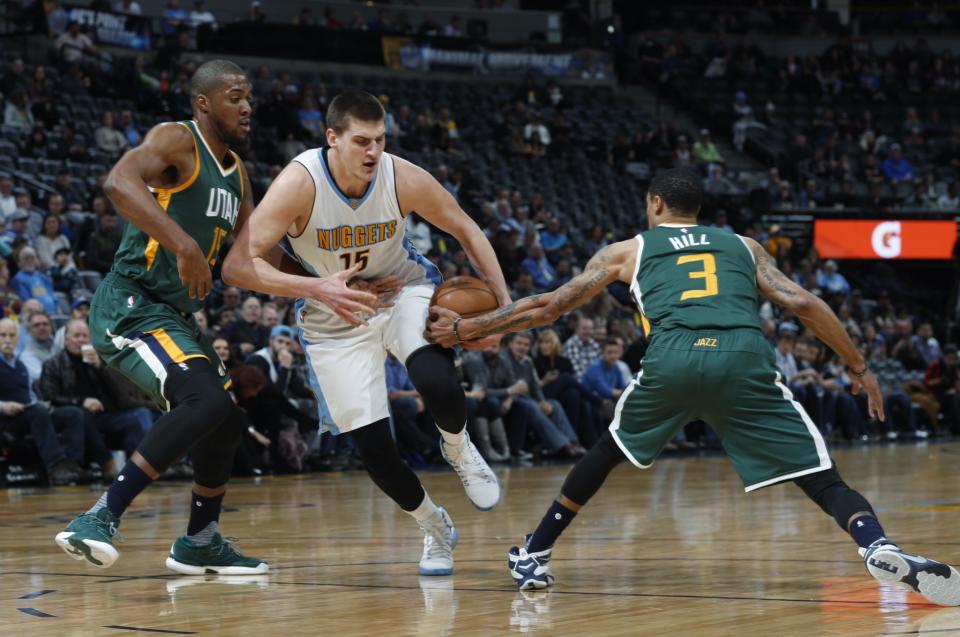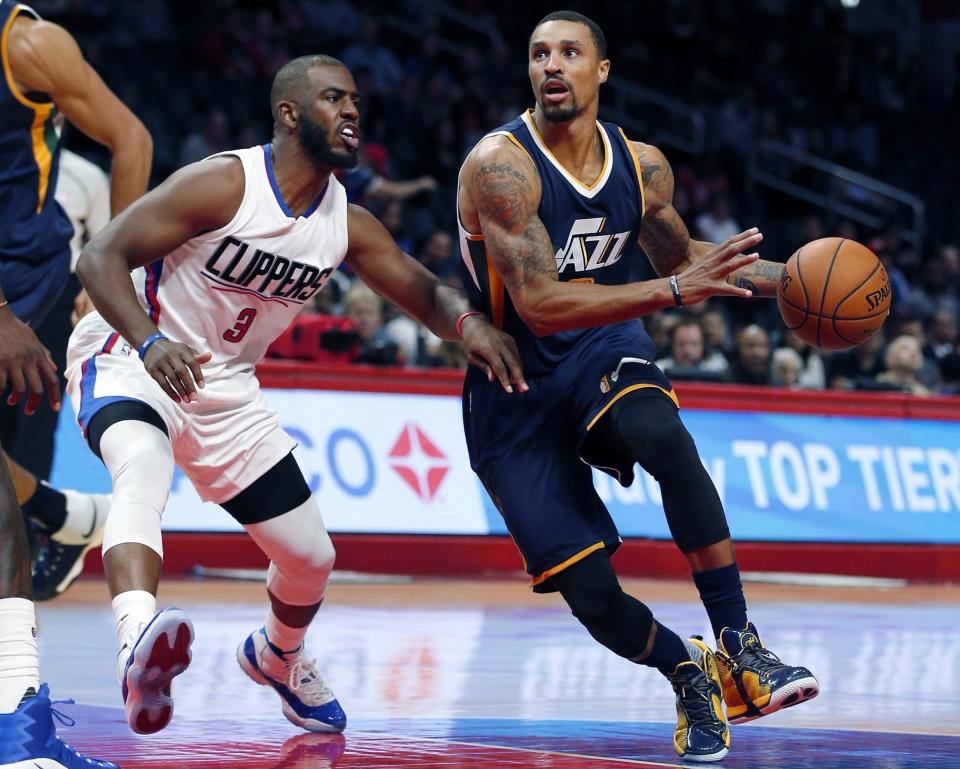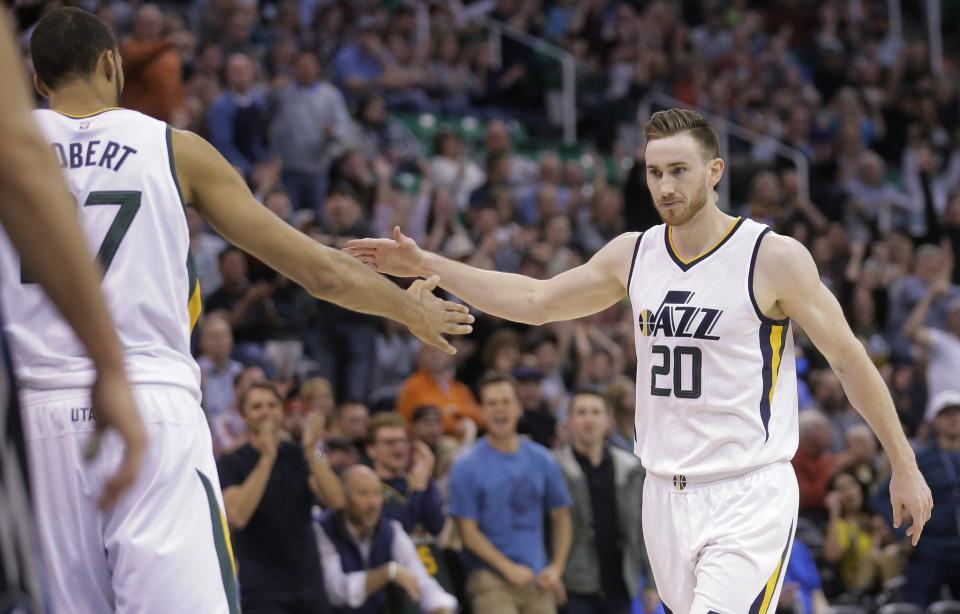BDL's 2016-17 NBA Playoff Previews: Los Angeles Clippers vs. Utah Jazz
How They Got Here
• Clippers: The Clips opened the season a blistering 14-2, fueled by elite defensive work and a stellar start from their second unit (incumbents Jamal Crawford, Austin Rivers and Wesley Johnson, joined by veteran free-agent signings Raymond Felton and Marreese Speights) that stoked hopes this would be the year they could challenge for a title. They’d cool over the holidays, though, suffering several convincing defeats between Thanksgiving and New Year’s Eve to settle into the middle of the Western Conference pack.
Then came the injuries. Blake Griffin needed arthroscopic knee surgery, putting him on the shelf for 18 games. Just as Griffin was nearing his return, Chris Paul tore a ligament in his left thumb, sidelining him for 14 and keeping L.A. from fielding its full squad from Christmas until after the All-Star break.
The Clips suffered some rough losses in that span — most notably a 46-point decimation by the Golden State Warriors team that has haunted L.A. for the last three years, and another heartbreaker that saw Golden State snatch away victory with a 50-point third quarter. But Doc Rivers’ veteran crew stayed afloat, weathered a long stretch of mediocrity (especially on the defensive end) and has started to hit its stride.
The Clippers owned the league’s No. 1 offense and fifth-best record over the final month of the season. They outscored opponents by 9.6 points per 100 possessions in that span; only Golden State boasted a better net rating. And, perhaps most importantly, they finished off a 3-1 win in their season series with Utah, affording them home-court advantage in a series between what looks like two pretty evenly matched teams.
[Sign up for Yahoo Fantasy Baseball: It’s not too late to get in the game]
• Jazz: Picked by many over the summer as the team most likely to rise in the West, Utah managed to fulfill those preseason expectations despite fielding its full expected starting five for fewer than 15 games.
All-Star playmaker Gordon Hayward, power forward Derrick Favors, smooth swingman Rodney Hood and offseason acquisition George Hill all missed chunks of time due to injury, forcing Quin Snyder to shuffle his personnel more than any other coach in the league. But the Jazz persevered, chugging along and winning 50 games for the first time since 2010 thanks largely to the towering presence and improved game of center Rudy Gobert, the 7-foot-2 man in the middle of the NBA’s No. 3 defense.
General manager Dennis Lindsey built a deep, versatile roster, combining cost-effective buys in free agency (Joe Johnson, still a professional scorer some 15 years after his NBA debut) and smartly targeted additions in the trade market (Hill, Boris Diaw) with a homegrown group of draft picks on whose internal development the fate of the franchise rests. The end result: a team chock full of long-limbed, athletic and skilled players capable of playing multiple different styles.
What makes Utah particularly interesting entering the postseason: for the first time in quite a while, the Jazz finally have all of their principal pieces (mostly) healthy and ready to go. We haven’t gotten many chances this season to see how formidable Utah can be at full strength. There’s no time like the present, and no stage like the postseason, to find out.

Head-to-Head
The Clippers took the season series, three games to one, though it’s tough to know just how much we can take from that.
Way back in October, just six days into the season, the Clips scored an 88-75 win over a Jazz team laboring without Hayward, who missed the first six games of the campaign with a broken finger on his left hand. Utah shot just 39.7 percent as a team against a Clipper defense in the midst of an early-season run that had many praising it as one of the league’s best. L.A. didn’t exactly light the world on fire itself — 41 percent from the field, 6-for-27 from 3-point range — but 19 points off the bench from Austin Rivers and an 18-point, 10-rebound double-double for Griffin was enough.
Three and a half months later, the Clippers once again come out on top in a low-scoring affair, earning an 88-72 victory in Salt Lake City behind a strong outing from Griffin (26 points, 10 rebounds, six assists, two blocks in 33 1/2 minutes) that helped minimize the pain of playing without Paul, who’d just gone out with the torn thumb ligament. Again, the Clippers forced Utah into a dismal shooting performance (32.2 percent from the field, 4-for-23 from long distance) that dropped the Jazz one game in the loss column behind L.A. in the standings.
“I feel like we didn’t want it more than they wanted it tonight,” Gobert said, according to Kareem Copeland of The Associated Press. “When it’s a game like that, you have to know it’s a game you can regret at the end of the season.”
(Prescient words, Rudy!)
Utah got on the board against the Clips the following month, riding big nights from Hayward (27 points, four assists, three rebounds), Hill (19 points, eight rebounds, six assists) and Joe Ingles (18 points on 6-for-9 shooting, 3-for-4 from deep) to a hard-fought 114-108 win that saw Paul star (33 points, seven assists, six rebounds) and Griffin struggle mightily (just eight points on eight shots in 36 1/2 minutes, unable to use his superior size to barrel through Hayward on multiple late-game post-ups).
The win gave the Jazz a two-game lead over L.A. in the race for the No. 4 seed and, at that moment, with the Clipper D having taken a clear step back from its early-season form, an apparent edge in their head-to-head matchup. That edge disappeared in short order.
Two weeks later, back at Staples Center, the Clips beat the Jazz by double digits for the third time this season, 108-95. L.A. built a big first-half lead behind the shooting of Griffin and Jamal Crawford, watched it disappear in the third as Gobert and Joe Johnson took over, and then blew Utah’s doors off in the fourth, as Crawford poured in 17 final-frame points to help the Clips clinch their playoff berth.
After the game, Gobert lit into his teammates for coming into a pivotal contest against a likely first-round opponent without the appropriate mindset:
“I think everybody needs to think about making plays for the team, making winning plays, before thinking about how many points we’re going to score and stuff like that,” Gobert said. “Everybody has to be ready to sacrifice. In the playoffs, it’s not going to be pretty. There’s going to be some games where you don’t score. But are you going to take a charge for a teammate? Are you going to come and box out DeAndre [Jordan] for a teammate?
“It works with all of us. And we do it, we do it, but we do it by stretches. We need to do it right from the beginning of the game. I think when we do that, we’re very, very, very good.”
And when they don’t, they can be susceptible to the sort of big runs that can tilt a game, and perhaps a series.
Likely Starting Lineups
For the Clippers: the time-honored quintet of Paul and J.J. Redick in the backcourt, Griffin and Jordan up front, and Luc Mbah a Moute on the wing. It’s a fivesome that has logged 871 minutes together this season, third-most by any five-man unit in the NBA, despite both Griffin and Paul missing more than 20 games and all five players having been available in only 46 total contests.
There’s a reason why Doc Rivers has leaned so heavily on his starters, though. This lineup smokes people, outscoring the opposition by 15.8 points per 100 possessions this season. That’s the third-best mark of any group to share the floor for at least 200 minutes, trailing only the Golden State Warriors’ starting lineup and the small-ball “Death Lineup” that replaces Zaza Pachulia with Andre Iguodala.
Paul orchestrates in the high screen game, pairing with Jordan and Griffin to give L.A. one of the league’s most fearsome pick-and-roll attacks. The Clippers ranked first in the league in points scored per possession by roll men and fourth in the NBA in points per possession by pick-and-roll ball-handlers, according to Synergy Sports Technology’s game charting. Jordan finishes everything lofted into his vicinity, shooting an NBA-high and career-best 71.4 percent from the field, while acting as one of the league’s premier shot-blockers and defensive rebounders.
Griffin’s game has moved from the front of the rim toward the perimeter over the course of his career. But he’s used his vision, touch and playmaking instinct to turn into one of the NBA’s best facilitators from the area around the free-throw line, ranking fourth in the league in points scored and assists dished off of elbow touches, and remains a devastating all-around weapon, averaging 22.2 points, 7.6 rebounds and 5.2 assists per game since Feb. 1 while shooting 50.5 percent from the field and 36.7 percent from 3-point range.
Redick tortures wing defenders off the ball, sprinting through actions to curl off screens for quick-release bombs that he drills at a 44.9 percent clip, 10th-best in the NBA among shooters firing at least two catch-and-shoot 3-pointers a game. The 30-year-old Mbah a Moute checks the opponent’s top wing scorer, gets his hands in passing lanes, makes opponents pay for forgetting he’s parked out of sight (96 of his 110 3-point tries have come from the short corners, and he’s knocked them down at a 38.5 percent clip) and generally fills in the gaps.
Outside of the monster factory that is Oracle Arena, the Clips’ starting five has been as good as it gets this year. If L.A.’s going to get past a tough, deep Utah squad, this group will have to log major minutes, and dominate while doing so.
[Follow Ball Don’t Lie on social media: Twitter | Instagram | Facebook | Tumblr]
For Utah … well, this one’s a bit tougher.

See, the Jazz have been so beset by injury that Quin Snyder has had to use 23 different starting lineups, with no one five-man unit logging more than 175 shared minutes. According to injury analyst Nathan Currier of Man-Games Lost, as of April 9, only four teams had seen their players miss more games due to injury, and no team had suffered a more significant impact from those absences than the Jazz, whom Currier estimates dropped nine wins thanks to missing personnel.
The group that was intended to be Utah’s starting lineup heading into the season — Gobert, Favors, Hayward, Hood and Hill — was only available for 14 of the campaign’s 82 games, and only five times since the All-Star break. Favors has played just three times since March 6, limited to 21 or fewer minutes in all of them as he works through a bone bruise on his left knee that had him “playing on one leg” for months, but that he says feels much better now, thanks. Hood’s right knee has bothered and hindered him since he hyperextended it in mid-January, causing him to miss 17 games over the final three months of the season, and struggle to find consistency with his shot when he did take the floor.
Hayward’s carrying a left quad contusion into the postseason. Hill just returned to the lineup after missing six games with a groin strain, and has battled a laundry list of issues in his first year in Salt Lake City.
The whole gang’s expected to be available for Game 1, but it’s reasonable to wonder whether running them out there is Snyder’s best bet. Yes, the Jazz went a sterling 12-2 in the games in which they were available, but that particular five-man unit actually got outscored over the course of its 152 minutes. Utah’s most effective lineups this season have featured various sub-package combinations, with playmaking forward Diaw and aggressive sophomore guard Dante Exum slotting in for Favors and Hill alongside Gobert-Hayward-Hood (plus-61 in 128 minutes); with savvy sharpshooter Ingles stepping in for Hood alongside Gobert-Hayward-Favors-Hill (plus-59 in 149 minutes); and with Diaw replacing Favors alongside Gobert-Hayward-Hood-Hill (plus-35 in 119 minutes).
Will a not-quite-two-legged Favors survive an ass-kicking contest against Griffin, who’s been excellent since returning from surgery? If not, can a 34-year-old and not-so-svelte-these-days Diaw? Will Hood be able to grit his teeth through all the changes of direction necessary to track Redick, or to use his superior size to punish the smaller Redick on the other end? If not, can the steadier but less explosive Ingles?
Might Snyder throw a curveball and trust a key defensive assignment to Exum, who’s got more than enough size (6-foot-6, 190 pounds, with a 6-foot-9-1/2 wingspan) and quickness to envelop opposing wings? Can a 21-year-old postseason rookie prone to inconsistency and poor shooting meet the challenge and earn his spot on the floor?
We likely won’t know for sure just how cohesive and in-rhythm Utah’s starters will be — or how much their relative health and well-being will impact Snyder’s rotation management — until the ball goes up. At least the Jazz have plenty of practice making something tasty of whatever ingredients they’ve got available.

Matchups to Watch
• How the Clips attack Gobert. One of the most fearsome defenders in the sport, Gobert led the NBA this season in total blocks, blocks per game, block percentage and defensive win shares, holding opponents to a minuscule 43.9 percent success rate at the rim on shots he contested. In the words of Sacramento Kings guard Garrett Temple, Gobert also “changes three times as many shots as he actually blocks” — to say nothing of the ones opponents never actually attempt, thanks to the intimidation he instills with his 7-foot-8-1/2-inch wingspan.
And yet, the Clippers roasted the Jazz when Gobert was on the floor this year, averaging a killer 115.6 points per 100 possessions with Rudy in the middle. L.A. nearly 48 percent from the field, and an eye-popping 64 percent in the paint.
So, how’d they do it?
For one thing, the Clips were judicious in their approach. Just 40 percent of their field-goal attempts when Gobert was on the floor came inside the paint — a slightly smaller share than when Gobert sat (43.4 percent) and a much smaller share than the NBA at large attempted against Gobert-led lineups this year (48.1 percent).
When L.A. did look to attack, though, they did so by leveraging one of the subtle strengths of a CP3-led offense, one highlighted by Rob Mahoney of Sports Illustrated in a great recent feature on Paul’s court vision: “The basis of Paul’s game is to create friction against instinct — to move a defender and immediately make him second-guess his own actions.”
Before approaching the rim, the Clippers worked to pull Gobert out of the paint first, forcing him to step up to corral Paul as he snaked away from a screen in the pick-and-roll, or to leap out of the lane as a last-line-of-defense option against a catch-and-shoot target running free after an off-ball screen:
How do you score at the rim against an elite rim protector? Move him away from the rim. https://t.co/ztqDWNtAOV
— Dan Devine (@YourManDevine) April 13, 2017
Having Jordan — like Gobert, an elite finisher who feasts on putback chances — helped, too. Keep a body on him on the weak side at all times, and you allow other Clippers to attack one-on-one. Rotate to neutralize the on-ball threat, and DeAndre’s scoring two points, very loudly:
And make him guard a guy like him, who scares the crap out of you if you leave him alone away from the ball. https://t.co/7jozitWsdv
— Dan Devine (@YourManDevine) April 13, 2017
And sometimes, even the best interior defenders can’t keep top-quality finishers from getting theirs around the basket:
And also, um, just be really good at finishing. https://t.co/OUYAW1IaQK
— Dan Devine (@YourManDevine) April 13, 2017
One thing to note: Favors missed two of the four games against L.A. this year, and shared the floor with Gobert for only 15 of his 46 total minutes. The Clippers scored at a rate of 97.3 points-per-100 in that microscopic sample, but that mark tracks with how the Gobert-Favors duo locked down opposing offenses over the course of the season as a whole (96.5 points-per-100 allowed in 541 minutes).
If Favors really is healthy enough to operate at full strength, he’d provide a welcome second-in-command to step in and put out fires when Gobert has to roam, which could make life much tougher on the Clips. If he can’t ride shotgun on paint protection, though, then whether and to what degree L.A. can make Gobert move could be the deciding factor in this series.

• CP3 vs. Hill. Few think of George Hill as a top-flight point guard. But quiet as it’s kept — in part because of the myriad injuries that cost him 33 games, and in part because most things about him have always been quiet (with the brief but notable exceptions of his blonde ambition and the time he told us about his childhood horse, Ropey) — Hill was awesome for the Jazz when healthy this year.
He averaged a career-high 16.9 points per game along with 4.1 assists, 3.4 rebounds and one steal in 31.5 minutes per contest, shooting 47.7 percent from the field, 40.3 percent from 3-point land and 80.1 percent from the foul line. His overall production was roughly on par with what it was two seasons ago, when Paul George’s season-ending leg fracture forced Hill to get aggressive and take over the Indiana Pacers’ offense. The result has been something like the perfect point guard to work alongside creative wings like Hayward and Hood in Snyder’s motion system.
Paul’s a much higher-wattage star, his season has kind of flown under the radar, too. If he hadn’t missed those five weeks following thumb surgery, he very well could have landed in the MVP conversation.
He averaged 18.1 points, 9.2 assists, 5.0 rebounds and 1.9 steals in 31.5 minutes per game this season on sterling 47.6/41.1/89.2 shooting splits. Efficiency-based advanced metrics loved CP3, as he led all NBA players in Real Plus-Minus, an estimate of how many points a player adds to or subtracts from his team’s point total over the course of 100 possessions; ranked third in win shares per 48 minutes and box plus-minus; and finished ninth in Player Efficiency Rating.
Both L.A. and Utah go from marginal to magnificent when their lead ball-handlers are in the mix. The Jazz outscored opponents by 8.6 points-per-100 with Hill in the lineup, compared to +2.2-per-100 when he sat, an efficiency differential equivalent to the gap between the 55-win Houston Rockets and the 31-win Minnesota Timberwolves. The separation was even starker for the Clips, who torched the opposition by a whopping 14.9 points-per-100 in CP3’s 1,900-plus minutes and got outscored by 5.3 points-per-100 without him — essentially, the difference between a supercharged version of the Warriors and an even-worse-than-the-real-thing Lakers.
Both are physical, aggressive defenders who can make life miserable on opposing ball-handlers, and while Paul’s clearly the more decorated individual performer, this is an opportunity for Hill — who’s set to hit unrestricted free agency this summer — to prove he can stand toe-to-toe with elite competition in a major role in the crucible of the postseason. Whichever point guard shines brightest could shift the balance of playmaking power in this series.

• Can Hayward break out? The 26-year-old swingman has gotten better year after year after year since coming out of Butler, increasing his per-game scoring in each of his seven seasons and developing into the No. 1 offensive option (and, often, lead ball-handler and playmaker) on a 50-win team. He was rewarded with his first All-Star berth this season, and now, he’ll be burdened with the expectation of leading an inexperienced Jazz team against one of the bracket’s most seasoned squads.
Hayward, like most of his teammates, struggled against L.A. this season. He averaged just 15.7 points in 31.8 minutes per game against the Clippers while shooting 38.1 percent from the field, dishing only seven assists against five turnovers in 95 total minutes of work. He was, however, dynamic in Utah’s one win, scoring 27 points on 50 percent shooting and even holding his own in defensive matchups against the bigger, stronger Griffin down the stretch:
Hayward’s slick enough to evade the tight defense of Mbah a Moute, big enough to bully smaller reserve defenders, and stout enough to hold up as a small-ball power forward if Snyder’s not getting what he wants offensively out of more traditional two-big lineups and wants to juice his offense by getting another wing shooter/playmaker on the floor. (Think Gobert-Hayward-Johnson-Ingles-Hill, which was plus-5.1-per-100 in 141 minutes, or Gobert-Hayward-Johnson-Hood-Hill, a plus-25.9-per-100 in 63 minutes.) But he’s got to be able to answer the bell against a locked-in defense focused primarily on stopping him, which is something he’s never had to do in a seven-game series.
If he’s ready for that challenge, Utah can pull the upset. If not, an offseason full of questions about opting out of his deal to hit free agency will begin much sooner than anybody in Salt Lake City wants.
How L.A. Could Win
Paul controls the proceedings. Griffin beasts whichever power forward Utah throws at him. Redick knocks down his looks, Jordan cleans up everything on both ends, and the Hayward-Hill-Hood trifecta’s not able to create and hit enough shots to hang around.
How Utah Could Win
Gobert and Hayward, not Paul, control the series. A fully healthy Jazz starting five is able to play the Clips to a standstill, and Snyder’s able to pull the right rotational levers to take advantage of Utah’s superior depth. An improbable buzzer-beater by either Ingles or Joe Johnson steals one at Staples, setting up the Jazz to close out on their home court and advance past the opening round for the first time since Jerry Sloan was roasting Kyrylo Fesenko for “jackpotting around.”
Best Reason to Watch
Here’s a few:
• CP3 teaching a master class in point guard play rivaled by very few people in the history of this league;
• A national audience getting an extended look (perhaps its first?) at why Hayward made his first All-Star team this year, and why Gobert should have;
• How amped the fans in Utah will be to watch a team four years in the making embark on its first postseason voyage together;
• The very real possibility that 35-year-old Joe Johnson — ol’ Iso Joe himself, a.k.a. Joe Jesus, a.k.a. The Armadillo Cowboy — winds up tilting the game with what-the-hell shot-making as an “in case of emergency, break glass” source of late offense;
• The even more real possibility that the outcome of this series determines whether Hayward decides to stay in Salt Lake City and/or whether the Clippers finally shake up their core.
Prediction: Clippers in 7.
– – – – – – –
Dan Devine is an editor for Ball Don’t Lie on Yahoo Sports. Have a tip? Email him at devine@yahoo-inc.com or follow him on Twitter!



